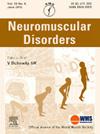Distinguishing immune checkpoint inhibitor-induced hypothyroid myopathy from myositis: a case report and review
IF 2.7
4区 医学
Q2 CLINICAL NEUROLOGY
引用次数: 0
Abstract
Immune checkpoint inhibitors (ICIs) have revolutionized cancer treatment; however, they can induce immune-related adverse events (irAEs), including hypothyroidism, the most common endocrine irAE. ICI-induced hypothyroid myopathy (ir-HM) is a rare condition that can be mistaken for ICI-induced myositis (ir-myositis). We encountered a case of ir-HM that was similar to ir-myositis. A 72-year-old male with lung cancer developed hypothyroidism and myopathy 21 weeks after initiating pembrolizumab treatment. Muscle biopsy revealed myofibrillar network disruption without inflammatory changes. A literature review identified 9 ir-HM cases, typically occurring more than 2 months after the initiation of ICI therapy. Key distinctions between ir-HM and ir-myositis include onset time, treatment approach, and the presence of the myoedema. Proper diagnosis of ir-HM is crucial for appropriate management, potentially allowing continuation of ICI therapy. This study highlights the importance of considering ir-HM in patients with myopathy symptoms occurring a longer period after the initiation of ICI treatment.
区分免疫检查点抑制剂诱导的甲状腺功能减退与肌炎:1例报告和回顾
免疫检查点抑制剂(ICIs)已经彻底改变了癌症治疗;然而,它们可以诱导免疫相关不良事件(irAEs),包括甲状腺功能减退,最常见的内分泌irAE。icii诱导的甲状腺功能减退肌病(ir-HM)是一种罕见的疾病,可被误认为icii诱导的肌炎(ir-myositis)。我们遇到了一个类似于肌炎的ir-HM病例。一名72岁男性肺癌患者在开始派姆单抗治疗21周后出现甲状腺功能减退和肌病。肌肉活检显示肌原纤维网络破坏,无炎症改变。文献回顾确定了9例ir-HM病例,通常发生在ICI治疗开始后2个多月。ir-HM和ir-肌炎的主要区别包括发病时间、治疗方法和是否存在肌水肿。正确诊断ir-HM对于适当的管理至关重要,可能允许继续ICI治疗。本研究强调了在ICI治疗开始后较长时间出现肌病症状的患者中考虑ir-HM的重要性。
本文章由计算机程序翻译,如有差异,请以英文原文为准。
求助全文
约1分钟内获得全文
求助全文
来源期刊

Neuromuscular Disorders
医学-临床神经学
CiteScore
4.60
自引率
3.60%
发文量
543
审稿时长
53 days
期刊介绍:
This international, multidisciplinary journal covers all aspects of neuromuscular disorders in childhood and adult life (including the muscular dystrophies, spinal muscular atrophies, hereditary neuropathies, congenital myopathies, myasthenias, myotonic syndromes, metabolic myopathies and inflammatory myopathies).
The Editors welcome original articles from all areas of the field:
• Clinical aspects, such as new clinical entities, case studies of interest, treatment, management and rehabilitation (including biomechanics, orthotic design and surgery).
• Basic scientific studies of relevance to the clinical syndromes, including advances in the fields of molecular biology and genetics.
• Studies of animal models relevant to the human diseases.
The journal is aimed at a wide range of clinicians, pathologists, associated paramedical professionals and clinical and basic scientists with an interest in the study of neuromuscular disorders.
 求助内容:
求助内容: 应助结果提醒方式:
应助结果提醒方式:


